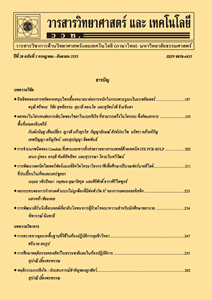ผลของน้ำสกัดชีวภาพต่อการเจริญเติบโต ผลผลิต และคุณภาพของมะละกอพันธุ์แขกดำศรีสะเกษ
Main Article Content
Abstract
บทคัดย่อ
การศึกษาผลของน้ำสกัดชีวภาพต่อการเจริญเติบโต ผลผลิต และคุณภาพของมะละกอพันธุ์แขกดำศรีสะเกษ เพื่อหาอัตราส่วนของน้ำสกัดชีวภาพที่ได้จากผักกวางตุ้งและปลาป่นที่เหมาะสมต่อการเจริญเติบโตและให้ผลผลิตของมะละกอ โดยรดด้วยสารละลายปุ๋ยเคมี 15-15-15 น้ำสกัดชีวภาพจากผักกวางตุ้ง น้ำสกัดชีวภาพจากปลาป่น ในอัตราส่วน 1:250 1:500 1:1,000 (น้ำสกัดชีวภาพ:น้ำ โดยปริมาตร) สัปดาห์ละหนึ่งครั้ง และการรดด้วยน้ำเป็นสิ่งทดลองควบคุม วางแผนการทดลองแบบบล๊อคสุ่มสมบูรณ์ (RCBD) มี 8 สิ่งทดลอง จำนวน 4 แปลง พบว่า ความสูง ขนาดเส้นผ่านศูนย์กลางลำต้น และจำนวนใบของมะละกอตลอดระยะเวลา 8 เดือนหลังย้ายปลูกไม่มีความแตกต่างทางสถิติในทุกสิ่งทดลอง อย่างไรก็ตาม จำนวนผล น้ำหนักผล และน้ำหนักผลรวมมีความแตกต่างอย่างมีนัยสำคัญทางสถิติ โดยต้นมะละกอที่รดด้วยน้ำสกัดชีวภาพผักกวางตุ้งในอัตราส่วน 1:250 ให้จำนวนผล และน้ำหนักผลรวมสูงที่สุด เท่ากับ 9.0 ผลและ 6.92 กิโลกรัมตามลำดับ ซึ่งไม่มีความแตกต่างทางสถิติกับต้นที่รดด้วยสารละลายปุ๋ยเคมี ส่วนน้ำหนักผลของต้นมะละกอที่รดด้วยสารละลายปุ๋ยเคมีมีน้ำหนักมากที่สุด คือ 841.8 กรัม ซึ่งก็ไม่แตกต่างทางสถิติกับต้นที่รดด้วยน้ำสกัดชีวภาพผักกวางตุ้งในอัตราส่วน 1:250 ส่วนขนาดผลและปริมาณของแข็งที่ละลายน้ำได้ไม่มีความแตกต่างทางสถิติ ปริมาณธาตุอาหารหลักในใบพบว่าไม่มีความแตกต่างกันทางสถิติ ดินหลังย้ายปลูกมะละกอ 8 เดือน มีปริมาณไนโตรเจนไม่มีความแตกต่างกันทางสถิติ ดินที่รดด้วยน้ำสกัดชีวภาพผักกวางตุ้งอัตราส่วน 1:250 มีอินทรียวัตถุน้อยที่สุดคือ 6.40% และดินที่รดด้วยสารละลายปุ๋ยเคมีมีค่า pH ลดลงมากที่สุดจาก pH 7.1 เป็น 6.23 ซึ่งมีความแตกต่างอย่างมีนัยสำคัญกับสิ่งทดลองอื่น ดังนั้นการใช้น้ำสกัดชีวภาพผักกวางตุ้งในอัตราส่วน 1:250 มีแนวโน้มต่อการเจริญเติบโตและการให้ผลผลิตของมะละกอใกล้เคียงกับการให้ปุ๋ยเคมี
คำสำคัญ : น้ำสลัดชีวภาพ; มะละกอพันธุ์แขกดำศรีสะเกษ; ผักกวางตุ้ง
Abstract
The effects of bioextracts on the growth, yield and quality of Carica papaya cv. Khaekdam-srisaket had been studied for appropriate ratios of Chinese green mustard and fish meal bioextracts affecting the growth and yield of papaya. The papaya plants were treated once a week with 15-15-15 fertilizer solution, bioextracts from Chinese green mustard and fish meal at the ratios of 1:250, 1:500 and 1:1,000 (bioextract:water, v/v) while water was the control treatment. The experiment was designed in RCBD with 8 treatments and 4 blocks. The results indicated that stem height, stem diameter, and the leaf number were not significantly different among the treatments during 8 months after transplanting. However, the number of fruits, the fruit weight and the total yield were significantly different among the treatments. The use of bioextract from the Chinese green mustard at 1:250 gave the highest fruit number and the total yield of 9.00 and 6.92 kg, respectively, which were not significantly different from the application of fertilizer solution. The fruit weight from the fertilizer solution treatment was the highest (841.8 g) and was not significantly different from the use of Chinese green mustard bioextract at the ratio of 1:250. The fruit size and total soluble solids (TSS) were not significantly different among the treatments. Percentages of N (3.80-4.15%), P (0.23-0.25%) and K (3.89-4.68%) in the papaya leaf were not significantly different among the treatments. For soil analysis after 8 month transplanting, N percentages were not significantly different among the treatments. The use of bioextract from Chinese green mustard at the ratio of 1:250 gave the lowest quantity of organic matter (6.40%). Inaddition, the soil pH was significantly decreased from 7.1 to 6.3 after the use of fertilizer solution. Therefore, using the bioextract from Chinese green mustard at the ratio of 1:250 and fertilizer solution gave the similar growth rate and yield of papaya.
Keywords: bioextracts; Carica papaya; chinese green mustard


